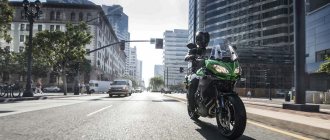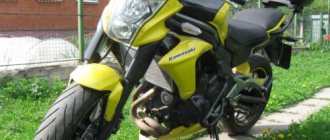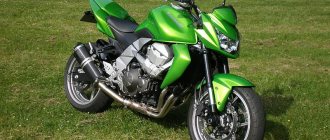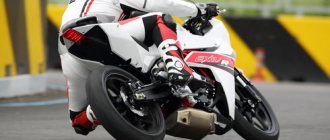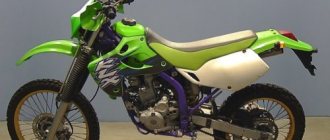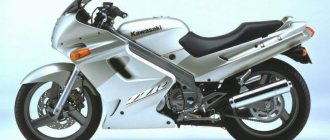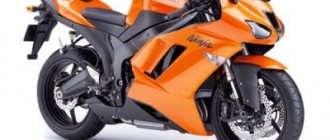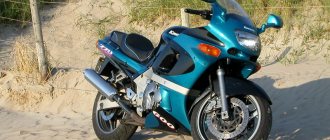The story of how such a successful model as the Kawasaki Versys 650 came to market is simple, but very instructive. Motorcyclists are a picky people, and most of them are well versed in steel horses with two wheels. It is very difficult, if not completely impossible, to please everyone at once, because the ideal motorcycle should be reliable, powerful, beautiful and at the same time inexpensive. And that’s without going into details! Because one biker will certainly be given long-travel suspensions, another will be given the opportunity to take another of the same bike disassembled on a motorcycle, the third will be able to accelerate from 0 to 100 km/h in a time during which you won’t even have time to say “mom”, the fourth will have spare parts in every city and the ability to repair most breakdowns “on the knee” in an open field with the help of a penknife, a screwdriver and a couple of strong expressions... That is why the Japanese concern “Kawasaki Heavy Industries” decided to take a risk by releasing to the market a strong “universal fighter”, a good a little of everything. However, to be honest, the risk was not that huge - the motorcycle, of course, was developed from scratch, but it was based on the popularly beloved ER-6, or simply “ruff”.
KLE Versys 650
In appearance, the Versys is a typical crossover, but in handling it is more reminiscent of a decent neoclassic.
The newcomer's specifications also include the name Kawasaki KLE 650. The bike is considered a continuation of this line, a replacement for the outdated KLE 500. Thus, we can say that the motorcycle has 2 parents , but in fairness, it is worth noting that it took more from the ER-6.
The motorcycle has gone through 2 restylings (the last one in 2015 ). Production continues. Users all over the world are offered both new and used versions. For a Russian user, the price of a used bike will be around 250,000 rubles or more . Here it should be noted that despite 4 modifications of the motorcycle, only one is sold in our markets - the basic one. True, thanks to this, the new owner receives a wide selection of branded parts for tuning, which is also not so bad.
Specifications
Engine – left view.
Engine – right side view.
Engine protection.
Exhaust pipes.
The developers did not reinvent the wheel. Taking the engine from the latest generations of the ER-6 (volume - 649 cubic meters), they reduced the power , but leveled the thrust throughout the entire rev range. The result obtained was installed on a new bike:
- working volume - 649 cm3;
- number of cylinders - 2 (in-line arrangement of pistons);
- number of cycles - 4;
- number of valves - 8 (4 per cylinder);
- power - 64 (69 from 2015) hp;
- torque - 61 (64 from 2015) Nm;
- cooling - liquid;
- fuel supply - injector, TTK38, 2x Keihin;
- ignition - transistor (TDI);
- start - electric starter;
- tank volume - 19 (21 from 2015) l.
2015, which appears in several indicators, is a radical redesign of the engine . Power and thrust have increased, consumption has decreased. Taking advantage of the latter circumstance, the fuel tank was reduced, as a result of which the motorcycle became lighter, and therefore more dynamic, maneuverable, and easier to control.
Transmission and clutch
The main drive is a classic chain drive.
Having the ER-6 as its ancestors, the bike should have received the same 6-speed gearbox.
They didn’t reinvent it, so it has the same characteristics as its parent:
- soft,
- shifts well;
- does not present surprises to the user.
The only change is that it has become more elastic . According to user reviews, by turning on the sixth, you can trudge at 40, or anneal at 200.
- Multi-disc clutch using an oil bath . Power transmission is a cable .
- The main drive is chain .
Brakes
Front brakes – 2 discs.
Rear brake – 1 disc.
But in the brake system they decided to change the parameters a little. The basic principles remain the same, disc brakes are hydraulically supported, but the diameter of the disc has changed.
Front:
- number of disks - 2;
- disk diameter - 320 mm;
- support - 2-piston.
Rear:
- number of disks - 1;
- disc diameter - 250 mm;
- support - 1-piston.
Since Kawasaki began using ABS systems in 2007, the Versys receives it as standard.
Engine
An in-line, four-stroke, two-cylinder engine is quite common for such cars. Its working volume reaches 649 cm³. The motor is liquid cooled. There are four valves per cylinder. The engine compression ratio is 10.8:1. The ignition is transistor type. The fuel supply system is injection.
The maximum engine characteristics are as follows: at 7000 rpm the torque reaches 64 Nm. At 8500 rpm, power reaches 69 hp. These are average figures for the class, which will not impress naked riders, but will be quite acceptable for avid travelers.
Driving performance,
Although many owners accelerated the motorcycle to 200 km/h or more, the official speed announced by the Japanese is 189 km/h . It is curious that the bike has a muffler, but it is installed beyond the mark of 230 km/h enough for a normal user . Comfortable cruiser - 120 km/h . Users noted that the bike can do more without any problems - the acceleration is simply fantastic , but above the cruiser the air flow is cut off right at the helmet, and in addition to this, the mirrors “fold”.
Acceleration to hundreds
Acceleration from zero to 100 km - 4.7 seconds.
According to users, you can “do” most sports freely at a traffic light. In addition, the engine parameters are configured so that the 100 km mark is crossed once. Confident and strong traction up to 180 km/h.
Fuel consumption
According to the manufacturer's estimates, the motorcycle consumes 4.5 liters per 100 km. According to users, in order to increase consumption by more than 5 liters per 100 , you need to try very hard.
I decided to post about my motorcycle, purchased and used in Thailand. I will try to write about choosing a motorcycle, the nuances of purchasing, features of operation and maintenance, tuning and my general impressions. I want to say that this is my first motorcycle - a foreign car, before that in 1990 there was Minsk and in 1994 Planet 5 (and that, brother). And this is my first purchase of a motorcycle “over the hill”. If anyone is interested, let's go to the cut Why is this the title of the post?
I will try to write about choosing a motorcycle, the nuances of purchasing, features of operation and maintenance, tuning and my general impressions. I want to say that this is my first motorcycle - a foreign car, before that in 1990 there was Minsk and in 1994 Planet 5 (and that, brother). And this is my first purchase of a motorcycle “over the hill”. If anyone is interested, let's go to the cut Why is this the title of the post?
In Russia we often criticize high duties on foreign cars, age restrictions on the import of used cars, etc., etc., and, in principle, we are doing absolutely the right thing :). But as for Thailand, there’s just complete chaos here and the worst thing is that there’s no one to scold, well, that is, who, of course, but for this they can get a normal sentence, like 5 years, so no comments here 
Let's compare prices, for example, for (this model was brought to Russia and Thailand from Japan) Honda GL1800A Gold Wing in Russia costs approximately 1,100,000 rubles. Honda GL1800A Gold Wing in Thailand costs 1,650,000 baht, which, translated into rubles at today's exchange rate, would be 1,710,000 rubles. And all because the motorcycle was imported to Thailand and not produced in Thailand. Now let’s compare prices for a Honda CBR250 (this model was made in Thailand, imported to Russia from Japan) Russia - 255,000 rubles Thailand - 110,000 baht, approximately 113,000 rubles
Can you feel the difference? Let's move on.
Of the large models of motorcycles produced in Thailand, a year ago there were only Kawasakis and then up to 650cc (now there are also some Honda models with a capacity of 500cc). Finding used motorcycles such as Honda Africa Twin, Transalp, Yamaha Tenere and others (and I was looking at enduro-tourists) is practically no chance, due to high duties they were not imported here and, accordingly, there is no choice, but those that are sold , rather old and loose trash. And numerous bikes standing on the beach road and for rent (there are Hayabusas, there are CB1400s, there are Harleys and Z1000 and R1 and Tenere, transalps and many other interesting things) were imported into Thailand illegally (by designers), so there are no documents for them and It's hard to buy them legally. Therefore, there is no insurance for them, which is why tourists who risk renting such motorbikes get caught. Local cops turn a blind eye to this, apparently they have a percentage of the profit, and they solve road accident cases at once, making the farangs to blame in 100% of cases, even if it is clearly the Thai’s fault. Be careful in this matter!
Well, I just have to look from what they produce, namely from Kawasaki models. It’s not to say that I didn’t know about the existence of Versus, I not only knew but also drove it (I rented it, the report is on my blog).
I also rented EP6 and this one
But still, Versus was more suitable for travel. After looking at ads for used Versuses and not finding anything worthwhile, I decided to buy a new one from the showroom. It was October 2012. The new Versus in Pattaya cost 295,000 baht. (in Russia 415,000 rubles), the difference is noticeable. But imagine my surprise when, upon arriving at the Kawasaki center, I did not see a single Versus.
After looking at ads for used Versuses and not finding anything worthwhile, I decided to buy a new one from the showroom. It was October 2012. The new Versus in Pattaya cost 295,000 baht. (in Russia 415,000 rubles), the difference is noticeable. But imagine my surprise when, upon arriving at the Kawasaki center, I did not see a single Versus. Wait 2 months, the administrator told me. That translated into Russian may not be two months, but much longer (I was waiting for my horn on the bike, instead of 2 months it was as much as 6 months). Great, I thought, and since there is only one Kawasaki salon in Pattaya, I went to Bangkok to look for other salons. Found. Only red and green colors were available (exactly the ones I didn’t want, well, I don’t like green and red Versus, for the life of me!). Again they advised to wait, in a couple of months white and yellow will appear. Well, no matter what, I dreamed of black... Do dreams come true? What do you think? I'll tell you this, if you really want it, it will come true! And I really wanted it, I was just exhausted :))) And so, having returned to Pattaya, I sat with a friend at the computer on the Internet, looking for information now about my dream - Versus. And then the sidekick saw an advertisement for the sale of Versus. The advertisement was submitted by a certain Dane Derek. This was the mot that was needed. Black, 2012, mileage 1400 km, first class insurance (Casco), the price of which for the year is 14,000 baht and a GIVI central case (price in Thailand 19,100 baht + mounting approximately 6,000 baht) for the motorcycle the Dane asked 270,000 baht. But the ad had been up for a month, which both made me happy and sad. I was glad that the moto hadn’t been sold yet, but I was also saddened by the same thing: if it hasn’t been sold yet, does that mean there’s some kind of problem with the moto?! I didn’t bother guessing, but dialed the phone number indicated in the ad. The arrow was shot the next morning. Mr. Derek Richard Collinson turned out to be an elderly man, about 60 years old. He speaks English very well and clearly, but this is not all his advantages, as it turned out. His main advantage is his accuracy and pedantry. The motorcycle was not only without a single scratch, there wasn’t even a speck of dust on it. The mileage increased slightly and amounted to 1600 km. Nonsense! Since the motorcycle had been on sale for a month, I easily bargained for ten and we agreed on 260,000 baht. (in order not to worry about the exchange rate of the ruble and baht, consider 1:1, this was the case last year). Friend Romka also needs to check how good this Versus is :))
Wait 2 months, the administrator told me. That translated into Russian may not be two months, but much longer (I was waiting for my horn on the bike, instead of 2 months it was as much as 6 months). Great, I thought, and since there is only one Kawasaki salon in Pattaya, I went to Bangkok to look for other salons. Found. Only red and green colors were available (exactly the ones I didn’t want, well, I don’t like green and red Versus, for the life of me!). Again they advised to wait, in a couple of months white and yellow will appear. Well, no matter what, I dreamed of black... Do dreams come true? What do you think? I'll tell you this, if you really want it, it will come true! And I really wanted it, I was just exhausted :))) And so, having returned to Pattaya, I sat with a friend at the computer on the Internet, looking for information now about my dream - Versus. And then the sidekick saw an advertisement for the sale of Versus. The advertisement was submitted by a certain Dane Derek. This was the mot that was needed. Black, 2012, mileage 1400 km, first class insurance (Casco), the price of which for the year is 14,000 baht and a GIVI central case (price in Thailand 19,100 baht + mounting approximately 6,000 baht) for the motorcycle the Dane asked 270,000 baht. But the ad had been up for a month, which both made me happy and sad. I was glad that the moto hadn’t been sold yet, but I was also saddened by the same thing: if it hasn’t been sold yet, does that mean there’s some kind of problem with the moto?! I didn’t bother guessing, but dialed the phone number indicated in the ad. The arrow was shot the next morning. Mr. Derek Richard Collinson turned out to be an elderly man, about 60 years old. He speaks English very well and clearly, but this is not all his advantages, as it turned out. His main advantage is his accuracy and pedantry. The motorcycle was not only without a single scratch, there wasn’t even a speck of dust on it. The mileage increased slightly and amounted to 1600 km. Nonsense! Since the motorcycle had been on sale for a month, I easily bargained for ten and we agreed on 260,000 baht. (in order not to worry about the exchange rate of the ruble and baht, consider 1:1, this was the case last year). Friend Romka also needs to check how good this Versus is :))
In total, I paid 260,000 baht for the Versus 2012, in the condition of a new motorcycle, with a case and comprehensive insurance, with a tax (a special piece of paper confirming the payment of tax on maintenance). Another plus was that the Versus already had white numbers (when you buy a new motorcycle, they give you red “transits” and only after a couple of months you will receive white numbers and documents for the bike, issued in your name, and in their absence, you will not be able to leave Thailand it seems possible, and in general it is not recommended to leave even the city in which you live, since the only documents confirming that this is your motorcycle are a certificate from the dealership in your name). The registration took 2 days. On the first day, I received a certificate from immigration that I have the right to sell or buy movable property in Thailand. To do this, you need a passport, a fresh stamp or visa to stay in the land of smiles, a rental agreement and a standard application. In the morning you hand over documents and money (200 baht, I think), after lunch you pick up chairs and a certificate. The next day we go to the traffic police at the traffic police, give the papers to the intermediary (a Thai woman, give her 200 baht for her services), registration and inspection of the motorcycle took about 1 hour and I received a Green Book (PTS) issued in my name.
I only disagree with one thing in this document, with the year of my birth - 2519, no, I’m still more used to my old year of birth, 1976 
That's all, now I'm free on MY VERSION on all four sides! And I immediately went to the Kawasaki center to put various “haharyashki” on it. I would like to note that all prices include installation. That is, when you buy any part in stores in Thailand, the price of this part includes installation, or as we say, installation is free! I changed the windshield to a high one (5000 baht) (we didn’t have glass like you, made of two halves), installed roll bars (8500 baht) and hand protection (4000 baht). The look has become more serious . And in general, I really like the appearance of the Versus, it’s still a beautiful motorcycle.
And I immediately went to the Kawasaki center to put various “haharyashki” on it. I would like to note that all prices include installation. That is, when you buy any part in stores in Thailand, the price of this part includes installation, or as we say, installation is free! I changed the windshield to a high one (5000 baht) (we didn’t have glass like you, made of two halves), installed roll bars (8500 baht) and hand protection (4000 baht). The look has become more serious . And in general, I really like the appearance of the Versus, it’s still a beautiful motorcycle.
I installed a 12 volt charger for 2 USB (1300 baht), tire pressure sensors (6500 rubles), a mount for a phone (navigator) (1100 baht). With Romka we installed a signal light brought from Russia (Starline V62 motorcycle) on the running board we installed an area-increasing gadget (something around 2000 baht) Fog lights (5500 baht) and xenon (1800 baht) low beam (In Thailand there is no ban on either xenon or strobes and other such topics) and radiator protection (2500 baht) and this other thing (120 baht), I don’t know what it’s called, but very useful on long-distance trips
And after 2 months (well, everything lasts 2 months ), at the end of December, the GIVI side panniers finally arrived (36,400 baht per pair) and the attachments for them (12,000 baht) and Versus became brutal
), at the end of December, the GIVI side panniers finally arrived (36,400 baht per pair) and the attachments for them (12,000 baht) and Versus became brutal (this is the configuration of the motorcycle that my wife and I have we went to Malaysia, but more on that in a separate post)
(this is the configuration of the motorcycle that my wife and I have we went to Malaysia, but more on that in a separate post)
My tuning didn't end there. I changed the signal (1000 baht) to “Volgovsky”
after 12000 km. mileage chain and 2 sprockets for “lightweight” ones (everything cost around 7500 baht) changed the rear axle to a reinforced one, with fall protection (3000 baht)
Headlight protection (800 baht)
Before a trip to Laos (I traveled with a friend for 2 weeks, recently returned) I bought toothy Pirelli tires (11600 baht set), a hugger (2500 baht) for the rear wheel and a second wing (1800 baht), which protect against throwing dirt at the rear passenger (or the trunk) . Pallet protection (8000 baht). And Versus became a little like a goose. And after returning from Laos, I decided to install a “gear sensor” (4300 baht). I would never have thought that I would need such a thing, but after a 2-week trip to Laos (there will be a post about this), I decided to install it (I’ll explain why in the post about Laos). And I also installed xenon on the high beam (1800 baht)
Pallet protection (8000 baht). And Versus became a little like a goose. And after returning from Laos, I decided to install a “gear sensor” (4300 baht). I would never have thought that I would need such a thing, but after a 2-week trip to Laos (there will be a post about this), I decided to install it (I’ll explain why in the post about Laos). And I also installed xenon on the high beam (1800 baht)
And also, pay attention to the seat, I put on a bubble cape (320 baht), which ventilates well when driving and dries clothes well after rain. This is a good thing in hot climates. But on long-distance trips, it seemed to me that the butt gets more tired, it is pressed with pimples into the soft tissue of the soft place :))
Well, that's all the tuning. I indicated the prices not for the sake of boasting, but for the sake of comparison with Russian ones, so comments about the prices for Thailand-Russia accessories are welcome.
Now about the motorcycle. I drove 16,500 km on it, that is, 10 times more than what was on the odometer when I bought it. I'm used to the motorcycle. Dropped it 4 times when trying to park unsuccessfully. Very high center of gravity, I can’t hold the bike even with a slight tilt. I dropped it once simply by forgetting to pull out the step, that was a laugh :)) During my travels I never dropped the bike, all the falls were near the house or at the Roma guest house (you park there at an angle), some kind of enchanted places :)) I have height 179cm, if the bike has panniers and a passenger, then I reach the ground firmly on 2 legs, if I have one, then on my toes. It steers very easily in motion, especially after changing tires to Pirelli ones (it was a road Dunlop). The dynamics are normal, but I’m already used to it and sometimes I want something faster, although in Thailand 650 cc is the ideal option, since the roads and traffic itself do not allow me to keep a cruising speed of more than 150 km/h for a long time. I really like the appearance, especially after such tuning. The color is black - fire! Here in Thailand it is very clean, so you don’t have to wash it often and the black color retains its shine for a long time :). There were no problems with the motorcycle, except for the clattering of the chain after 12,000 km. mileage, the problem was solved by replacing the chain and sprockets. After 10000 km. Some kind of whistling appeared at high speeds, but as I understand it, this is normal for Versus. Some parts under the steering wheel also vibrate until I get to the sound, and it’s annoying until the music starts playing in the helmet. The light of the headlights is phenomenal, it shines like a big jeep.
I drove 16,500 km on it, that is, 10 times more than what was on the odometer when I bought it. I'm used to the motorcycle. Dropped it 4 times when trying to park unsuccessfully. Very high center of gravity, I can’t hold the bike even with a slight tilt. I dropped it once simply by forgetting to pull out the step, that was a laugh :)) During my travels I never dropped the bike, all the falls were near the house or at the Roma guest house (you park there at an angle), some kind of enchanted places :)) I have height 179cm, if the bike has panniers and a passenger, then I reach the ground firmly on 2 legs, if I have one, then on my toes. It steers very easily in motion, especially after changing tires to Pirelli ones (it was a road Dunlop). The dynamics are normal, but I’m already used to it and sometimes I want something faster, although in Thailand 650 cc is the ideal option, since the roads and traffic itself do not allow me to keep a cruising speed of more than 150 km/h for a long time. I really like the appearance, especially after such tuning. The color is black - fire! Here in Thailand it is very clean, so you don’t have to wash it often and the black color retains its shine for a long time :). There were no problems with the motorcycle, except for the clattering of the chain after 12,000 km. mileage, the problem was solved by replacing the chain and sprockets. After 10000 km. Some kind of whistling appeared at high speeds, but as I understand it, this is normal for Versus. Some parts under the steering wheel also vibrate until I get to the sound, and it’s annoying until the music starts playing in the helmet. The light of the headlights is phenomenal, it shines like a big jeep. After installing xenon on the low beam, the spot of light became much larger and brighter, but now the high beam shines close, that is, if you set the high beam normally and turn it off, the low beam will still blind oncoming traffic. If you adjust the low beam normally, the high beam shines closer than you would like. When the original light (halogens) was in use, there was no such problem, since the coverage area of the low beam was smaller, and the gap between the low beam and the high beam was larger. But you don’t have to bother, anyway, I won’t remove the xenon ; fuel consumption at a speed of 100 km/h. approximately 4.5 liters, at 150 about 6 liters.
After installing xenon on the low beam, the spot of light became much larger and brighter, but now the high beam shines close, that is, if you set the high beam normally and turn it off, the low beam will still blind oncoming traffic. If you adjust the low beam normally, the high beam shines closer than you would like. When the original light (halogens) was in use, there was no such problem, since the coverage area of the low beam was smaller, and the gap between the low beam and the high beam was larger. But you don’t have to bother, anyway, I won’t remove the xenon ; fuel consumption at a speed of 100 km/h. approximately 4.5 liters, at 150 about 6 liters.
That’s basically all I wanted to tell you about the motorcycle, ask the rest, I’ll answer as best I can 
And finally, a couple of photos from different travels, but only a couple, so that there is something to surprise you in the following travel posts Bridge to Georgetown (Malaysia)
Bridge to Georgetown (Malaysia)
At the foot of the Petronos (Malaysia, Kuala Lumpur) And here are the towers themselves
Afternoon in Laos
Evening in Laos
At night in Laos
Well, me and my Versus 
Until we meet again, my travels are not over yet, we have a motorcycle season 365 days a year 
Dimensions and weight
The motorcycle is much lighter than most “street” bikes and only slightly heavier than modern sports cars.
In terms of its external parameters, the bike differs slightly from its parent:
Curb weight ER-6 - 211 kg , Versys - 208 kg . (Rating with ABS, since Versys has stock).
The dimensions also differ slightly - 10–15 cm back and forth. Versys 650 has:
- length - 2,165 (2,125) mm;
- width - 840 mm;
- in height - 1,400 ( 1,315 ) mm;
- Seat height - 840 ( 845 ) mm.
- Wheelbase - 1,415 mm.
Sizes up to 2015 are indicated in brackets. It is curious that the height of the saddle was initially 740 mm. After the first restyling it increased to 845 mm , after the second (2015) it returned to the initial mark.
For whom is it intended?
Although the motorcycle, among others, ended up on the Japanese markets, the height of the saddle completely cuts off people whose height is below average.
The “I sit high and look far” type of seating allows you to relax your back on a long trip, and in the city you can look over the cars.
And even then, a biker of average height will probably experience certain problems. The grooves on the floor knees on the tank, the height of the steering wheel/mirrors are ideal for a tall person.
Brief history of the model
2007 - start of production and sales of Kawasaki Versys 650. First generation. Model: Kawasaki Versys 650, Kawasaki Versys 650 ABS (all markets). Factory designation: KLE650A7F, KLE650B7F
2008 - no significant changes. Model: Kawasaki Versys 650, Kawasaki Versys 650 ABS (all markets). Factory designation: KLE650A8F, KLE650B8F
2009 - no significant changes. Model: Kawasaki Versys 650, Kawasaki Versys 650 ABS (all markets). Factory designation: KLE650A9F, KLE650B9F
2010 - restyling of the model. Second generation. The Kawasaki Versys 650 gets a new headlight, larger mirrors and a better engine mount. Model: Kawasaki Versys 650, Kawasaki Versys 650 ABS (all markets). Factory designation: KLE650CAF, KLE650DAF
2011 - no significant changes. Model: Kawasaki Versys 650, Kawasaki Versys 650 ABS (all markets). Factory designation: KLE650CBF, KLE650DBF
2012 - no significant changes. Model: Kawasaki Versys 650, Kawasaki Versys 650 ABS (all markets). Factory designation: KLE650CCF, KLE650DCF
2013 - no significant changes. Model: Kawasaki Versys 650, Kawasaki Versys 650 ABS (all markets). Factory designation: KLE650CDF, KLE650DDF
2014 - no significant changes. Model: Kawasaki Versys 650, Kawasaki Versys 650 ABS (all markets). Factory designation: KLE650CEF, KLE650DEF
2015 - restyling of the model. This year's models received new front optics, a retuned engine (69 hp, 64 Nm), a 21-liter fuel tank, and new front calipers. Model: Kawasaki Versys 650 ABS (all markets). Factory designation: KLE650FFF
2016 - no significant changes. Model: Kawasaki Versys 650 ABS (all markets). Factory designation: KLE650FGF
2017 - no significant changes. Model: Kawasaki Versys 650 ABS (all markets). Factory designation: KLE650FHF
2018 - no significant changes. Model: Kawasaki Versys 650 ABS (all markets). Factory designation: KLE650FJF
2019 - no significant changes. Model: Kawasaki Versys 650 ABS (all markets). Factory designation: KLE650FKF
2020 - no significant changes. Model: Kawasaki Versys 650 ABS (all markets). Factory designation: KLE650FLF
2021 - Maximum power reduced to 66 hp. Model: Kawasaki Versys 650 ABS (all markets). Factory designation: KLE650FMFNL
Modifications
Modifications of the model include versions with the Tourer prefix, produced in various trim levels.
Since the bike itself was a modification, they did not make additional ones based on it. But the ardent user could choose one of 4 configurations:
- Kawasaki Versys 650. Delivered to select countries, Clean bike, no bells and whistles.
- Kawasaki Versys 650 Tourer. Additionally, hand and tank protection are installed. And it is also equipped with removable side cases of 28 liters each. Inside the suitcase there is an additional bag. This is the version that can most often be found on Russian markets, but the availability of cases is not guaranteed.
- Kawasaki Versys 650 Tourer Plus. All the features of the previous version, as well as LED fog lights on the wings and a gear indicator on the instrument panel.
- Kawasaki Versys 650 Grand Tourer. A central case ( 47 l ) has been added to the capabilities of the Plus version, and a 12 V socket has been installed. Replaced battery.
and competitors
The bike's competitors are not so prolific, each company has one bike, with one configuration, but at the same time the capabilities are comparable.
Honda XL700V Transalp.
Suzuki V-Strom 650
Yamaxa XT660Z Tenere.
The first one that is often remembered when mentioning touring enduro is Yamaxa. XT660Z Tenere model was often considered the only worthy representative in this class.
Suzuki's answer was the V-Strom 650 .
Honda did something interesting. At that moment they were promoting their touring-enduro Transalp , and although there was a 650 cc model in the series, for comparison they offered an aging one - Honda XL700V Transalp .
Photo gallery
One of the unsung heroes of the motorcycle industry, the Kawasaki Versus 650 is an incredibly versatile bike at an affordable price. In the 2015 model year, the model was thoroughly updated, and first of all, the appearance of the motorcycle was improved.
We invite you to look at our photo selection and admire the updated bike.
Peculiarities
Front view.
Back view.
Dashboard.
Rear shock absorber.
- Good traction at any speed.
- There is also good elasticity , when in the same gear you can sharply tear away from a traffic light, “vomit” in traffic jams, or smoothly accelerate to overtake a crawling truck in front.
Disadvantages (few)
The agile and reliable engine of the motorcycle allows you to confidently maintain cruising speed, but upon further acceleration, vibration creates noticeable discomfort.
- Consumption. This is not noted by every user, but it is worth remembering that “gluttony” is directly dependent on the quality of the road on which the motorcycle is traveling; if it is a highway, the power reserve is approximately 350 km.
- Vibration . For 2 cylinders this is a rare thing, but it is present here. The truth is that it doesn’t particularly affect the controls, hands and buttocks. You can feel your legs and also the mirrors. If you turn the engine at speeds above 5k , the picture is completely broken.
and dignity
Readable mirrors.
Steel frame.
- Mirrors : from the reviews, “I don’t know how they did it, but the mirrors on the motorcycle are simply excellent, you can see everything, above below, on the left, on the right, you completely forget about the concept of “dead zones.”
- Reliability . Steel for the frame and off-road capabilities do not need comment.
- Engine . Smooth and strong thrust comparable to other liters.
In addition, they call handling, maneuverability, classic landing and much more.
Colors
Candy Burnt Orange:
Ebony:
Atomic Silver:
The above technical characteristics were obtained by testing product samples under normal conditions. This information is published in order to provide objective information about the parameters of the vehicle. However, the information provided may not be relevant for some product samples. Kawasaki Heavy Industries, Ltd. reserves the right to change product specifications without prior notice. Parts and assemblies shown in the illustrations, as well as their characteristics, may also differ depending on the region of delivery. Colors also vary by market.
